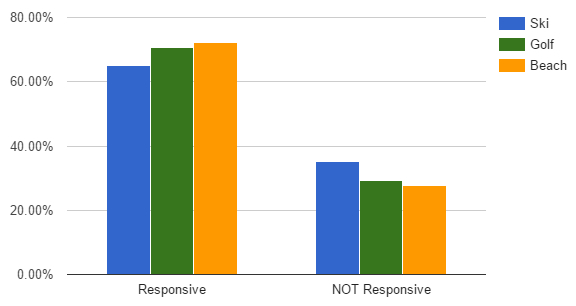
Trends

The rapid adoption of website responsiveness has been fascinating to watch. It’s part of the reason we’ve updated the progress twice over the last few years (once in December 2014 and year ago in April 2016). But wanting to see if last year’s incredible growth has continued, we’ve revisited the numbers again in 2017 to see how things are going. Here’s what we saw.
The Goods
To find our answer we used the same group of 800 ski, beach, and golf resort websites from the previous two analyses and ran the exact same criteria against each to determine how many were responsive. Again, this includes responsive websites only, not m-dot sites (e.g., “m.myresort.com”).
From just over 50% adoption a year ago, each of the three verticals we looked at have eclipsed 65% with beach coming out on top at 72%. From our sample of 800 websites, more than 120 additional websites have become responsive during the last 12 months.
What This Means
There are two points to consider. The first is simple, straightforward, and actionable. If you haven’t adopted responsive design, your brand is now the exception rather than the rule. That’s an important tipping point for any marketing channel.
The second is that this latest jump really is significant. Adoption is never a linear path to 100%, so the fact that this latest data point is almost in line with the previous two – a 15 percentage point increase versus a 20 percentage point increase – is incredible and an important footnote.
Next Week, More
We’ve been publishing new resort- and hotel-specific marketing insights like this one every week since 2012. Don’t want to miss the next one? Stick your email below.